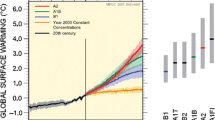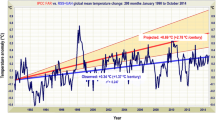Abstract
Ignorance is an inevitable component of climate change research, and yet it has not been specifically catered for in standard uncertainty guidance documents for climate assessments. Reports of ignorance in understanding require context to explain how such ignorance does and does not affect understanding more generally. The focus of this article is on dynamical sources of ignorance in regional climate change projections. A key source of ignorance in the projections is the resolution-limited treatment of dynamical instabilities in the ocean component of coupled climate models. A consequence of this limitation is that it is very difficult to quantify uncertainty in regional projections of climate variables that depend critically upon the details of the atmospheric flow. The standard methods for quantifying or reducing uncertainty in regional projections are predicated on the models capturing and representing the key dynamical instabilities, which is doubtful for present coupled models. This limitation does not apply to all regional projections, nor does it apply to the fundamental findings of greenhouse climate change. Much of what is known is not highly flow-dependent and follows from well grounded radiative physics and thermodynamic principles. The growing field of applications of regional climate projections would benefit from a more critical appraisal of ignorance in these projections.

Similar content being viewed by others
Notes
The term ‘dynamics’ is used here to refer to model instabilities and flow simulated from the model primitive equations as distinct from ‘physics’ represented by radiation, convection, and other model processes.
References
Bolin B (1994) Science and policy making. Ambio 23(1):25–29
Christensen J, Hewitson B, Busuioc A, Chen A, Gao X, Held R, Jones R, Kolli R, Kwon W, Laprise R et al (2007) Regional climate projections. In: Climate change 2007: the physical science basis. Contribution of working group 1 to the fourth assessment report of the intergovernmental panel on climate change, chapter 11. Cambridge University Press, Cambridge, UK
Cunnington WM, Mitchell J (1990) On the dependence of climate sensitivity on convective parametrization. Clim Dynam 4(2):85–93
Dickinson R (1985) Climate sensitivity. Adv Geophys 28(1):99–129
Frederiksen J, Frederiksen C (2007) Inter-decadal changes in Southern Hemisphere winter storm track modes. Tellus 59(5):599–617
Frederiksen J, O’Kane T (2008) Entropy, closures and subgrid modeling. Entropy 10(4):635–683
Frederiksen J, Dix M, Kepert S (1996) Systematic energy errors and the tendency toward canonical equilibrium in atmospheric circulation models. J Atmos Sci 53(6):887–904
Funtowicz S, Ravetz J (1990) Uncertainty and quality in science for policy. Kluwer, Dordrecht, 229pp
Giorgi F, Hewitson B et al (2001) Regional climate information—evaluation and projections. In: Climate change 2001: the scientific basis, chapter 10, pp 583–638. Cambridge University Press, Cambridge, UK, 881pp
Griffies S, Hallberg R (2000) Biharmonic friction with a Smagorinsky-like viscosity for use in large-scale eddy-permitting ocean models. Mon Weather Rev 128(8):2935–2946
Guilyardi E, Wittenberg A, Fedorov A, Collins M, Wang C, Capotondi A, van Oldenborgh G, Stockdale T (2009) Understanding El Niño in ocean-atmosphere general circulation models: progress and challenges. Bull Am Meteorol Soc 90(3):325–340
Hansen J, Takahashi T (1984) Climate processes and climate sensitivity. AGU Geophys Monogr 29(Maurice Ewing, vol 5)
Hansen J, Rind D, Del Genio A, Lacis A, Lebedeff S, Prather M, Ruedy R, Karl T (1989) Regional greenhouse climate effects. In: Coping with climatic change: proceedings of the second north American conference on preparing for climate change. The Climate Institute, Washington, DC
Hansen J, Sato M, Kharecha P, Beerling D, Berner R, Masson-Delmotte V, Pagani M, Raymo M, Royer D, Zachos J (2008) Target atmospheric \(\mbox{CO}_{2}\): where should humanity aim? Open Atmos Sci J 2:217–231
Hawkins E, Sutton R (2009) The potential to narrow uncertainty in regional climate predictions. Bull Am Meteorol Soc 90(8):1095–1107
Hegerl G, Crowley T, Hyde W, Frame D (2006) Climate sensitivity constrained by temperature reconstructions over the past seven centuries. Nature 440(7087):1029–1032
Held I (1993) Large-scale dynamics and global warming. Bull Am Meteorol Soc 74(2):228–241
Held I, Soden B (2006) Robust responses of the hydrological cycle to global warming. J Climate 19(21):5686–5699
Houghton JT et al (eds) (1996) Climate change 1995: the science of climate change. Cambridge University Press, Cambridge, UK, 572pp
Houghton JT, Jenkins G, Ephraums J (eds) (1990) Climate change: the IPCC scientific assessment. Cambridge University Press, Cambridge, UK, 365pp
Houghton JT, Ding Y, Griggs DJ, Noguer M, van der Linden PJ, Dai X, Maskell K, Johnson CA (eds) (2001) Climate change 2001: the scientific basis. Cambridge University Press, Cambridge, UK, 881pp
IPCC (2006) Guidance notes for lead authors of the IPCC fourth assessment report on addressing uncertainties. Appendix in Manning 2006 Adv. Cli. Cha. Res., vol 2, pp 13–21
Kalnay E (2002) Atmospheric modeling, data assimilation and predictability. Cambridge University Press, Cambridge, UK, 364pp
Kandlikar M, Risbey J, Dessai S (2005) Representing and communicating deep uncertainty in climate change assessments. Comptes Rendus Geoscience 337(4):443–455
Lal M, Ramanathan V (1984) The effects of moist convection and water vapor radiative processes on climate sensitivity. J Atmos Sci 41(14):2238–2249
Lewis J (1998) Clarifying the dynamics of the general circulation: Phillips’s 1956 experiment. Bull Am Meteorol Soc 79(1):39–60
Lorenz E (1969) The predictability of a flow which possesses many scales of motion. Tellus 21(3):289–307
Lorius C, Jouzel J, Raynaud D, Hansen J, Le Treut H (1990) The ice-core record: climate sensitivity and future greenhouse warming. Nature 347(6289):139–145
Lynch P (2006) The emergence of numerical weather prediction: Richardson’s dream. Cambridge University Press, Cambridge, UK, 279pp
Manabe S, Wetherald R (1967) Thermal equilibrium of the atmosphere with a given distribution of relative humidity. J Atmos Sci 24(3):241–259
Manabe S, Wetherald R, Stouffer R (1981) Summer dryness due to an increase of atmospheric CO2 concentration. Clim Change 3(4):347–386
Mastrandrea M, Field C, Stocker T, Edenhofer O, Ebi K, Frame D, Held H, Kriegler E, Mach K, Plattner G, Yohe G, Zwiers F (2010) Guidance notes for lead authors of the IPCC fifth assessment report on consistent treatment of uncertainties. Available at http://www.ipcc.ch
Maxino C, McAvaney B, Pitman A, Perkins S (2008) Ranking the AR4 climate models over the Murray–Darling basin using simulated maximum temperature, minimum temperature and precipitation. Int J Climatol 28(8):1097–1112
Meehl G, Covey C, Delworth T, Latif M, McAvaney B, Mitchell J, Stouffer R, Taylor K (2007) The WCRP CMIP3 multimodel dataset: a new era in climate change research. Bull Am Meteorol Soc 88(9):1383–1394
Mitchell J, Karoly DJ et al (2001) Detection of climate change and attribution of causes. In: Climate change 2001: the scientific basis, chapter 12, pp 695–738. Cambridge University Press, Cambridge, UK, 881pp
Moss R, Schneider SH (2000) Uncertainties in the IPCC TAR: recommendations to lead authors for more consistent assessment and reporting. In: Pachauri R, Taniguchi T, Tanaka K (eds) Guidance papers on the cross cutting issues of the third assessment report of the IPCC. Technical report, World Meteorological Organization, pp 33–51
O’Kane T, Frederiksen J (2008) Statistical dynamical subgrid-scale parameterizations for geophysical flows. Physica Scripta T132(010433)
O’Kane T, Frederiksen J, Dix M (2009) Sampling errors in estimation of the small scales of monthly mean climate. Atmos Ocean 47(2):160–168
Oppenheimer M, O Neill B, Webster M, Agrawala S (2007) The limits of consensus. Science 317(5844):1505–1506
Palmer T (2010) Is science fiction a genre for communicating scientific research? A case study in climate prediction. Bull Am Meteorol Soc 91(10):1413–1415
Palmer T, Doblas-Reyes F, Weisheimer A, Rodwell M (2008) Toward seamless prediction: calibration of climate change projections using seasonal forecasts. Bull Am Meteorol Soc 89(4):459–470
Paltridge G (2009) The climate caper. Quartet Books, London, 130pp
Parry M, Canziani O, Palutikof J, van der Linden P, Hanson C (eds) (2007) Climate change 2007: impacts, adaptation and vulnerability. In: Contribution of working group II to the fourth assessment report of the intergovernmental panel on climate change. Cambridge University Press, Cambridge, UK, 986pp
Pierrehumbert R (2011) Infrared radiation and planetary temperature. Phys Today 64(1):33–38
Ramanathan V, Coakley J (1978) Climate modeling through radiative-convective models. Rev Geophys Space Phys 16(4):465–489
Ramanathan V, Callis L, Cess R, Hansen J, Isaksen I, Kuhn W, Lacis A, Luther F, Mahlman J, Reck R, Schlesinger M (1987) Climate-chemical interactions and effects of changing atmospheric trace gases. Rev Geophys 25(7):1441–1482
Ravetz J (1986) Usable knowledge, usable ignorance: incomplete science with policy implications. In: Sustainable development of the biosphere, chapter 15. Cambridge University Press, Cambridge, UK, pp 415–432
Richardson L (1922) Weather prediction by numerical process. Cambridge University Press, Cambridge, UK. Reprinted by Dover Publications, 1965. Reprinted by Cambrige University Press, 2006
Risbey JS (2002) Comment on Soon et al 2002: modeling climatic effects of anthropogenic carbon dioxide emissions: unknowns and uncertainties. Clim Res 22(2):185–186
Risbey J (2010) The strawmen of climatology. Australas Sci 31(8):36–37
Risbey JS, Stone PH (1996) A case study of the adequacy of GCM simulations for input to regional climate change assessments. J Clim 9(7):1441–1467
Risbey J, Kandlikar M (2007) Expressions of likelihood and confidence in the IPCC uncertainty assessment process. Clim Change 85(1–2):19–31
Risbey JS, Lamb PJ, Miller RL, Morgan MC, Roe GH (2002) Exploring the structure of regional climate scenarios by combining synoptic and dynamic guidance and GCM output. J Clim 15(9):1036–1050
Scaife A, Woollings T, Knight J, Martin G, Hinton T (2010) Atmospheric blocking and mean biases in climate models. J Clim 23(23):6143–6152
Schneider T, O’Gorman P, Levine X (2010) Water vapor and the dynamics of climate changes. Rev Geophys 48(RG3001):1–22
Seager R, Naik N, Vecchi G (2010) Thermodynamic and dynamic mechanisms for large-scale changes in the hydrological cycle in response to global warming. J Clim 23(17):4561–4668
Senior C, Mitchell J (1993) Carbon dioxide and climate: the impact of cloud parameterization. J Clim 6(3):393–418
Shackley S, Risbey J, Stone P, Wynne B (1999) Adjusting to policy expectations in climate change modeling: an interdisciplinary study of flux adjustments in coupled atmosphere-ocean general circulation models. Clim Change 43(2):413–454
Sherwood S, Schmidt G (2011) Messy models. Bull Am Meteorol Soc (in press)
Shukla J, Palmer TN, Hagedorn R, Hoskins B, Kinter J, Marotzke J, Miller M, Slingo J (2010) Toward a new generation of world climate research and computing facilities. Bull Am Meteorol Soc 91(10):1407–1412
Simmons A, Hollingsworth A (2002) Some aspects of the improvement in skill of numerical weather prediction. Q J R Meteor Soc 128(580):647–677
Smith K (2007) The geography of linear baroclinic instability in Earth’s oceans. J Mar Res 65(5):655–683
Solomon S, Qin D, Manning M, Chen Z, Marquis M, Averyt K, Tignor M, Miller H (eds) (2007) Climate change 2007: the physical science basis. In: Contribution of working group 1 to the fourth assessment report of the intergovernmental panel on climate change. Cambridge University Press, Cambridge, UK, 996pp
Toth Z, Kalnay E (1997) Ensemble forecasting at NCEP and the breeding method. Mon Weather Rev 125(12):3297–3319
van der Sluijs J (1997) Anchoring amid uncertainty. University of Utrecht, Utrecht. PhD Thesis, 260pp
van der Sluijs J (2005) Uncertainty as a monster in the science-policy interface: four coping strategies. Water Sci Technol 52(6):87–92
van der Sluijs J, Eijndhoven J, Shackley S, Wynne B (1998) Anchoring devices in science for policy: the case of consensus around climate sensitivity. Soc Stud Sci 28(2):291–323
van der Sluijs J, van Est R, Riphagen M (2010) Beyond consensus: reflections from a democratic perspective on the interaction between climate politics and science. Current Opinion in Environ Sutainability 2(5–6):409–415
Vecchi G, Wittenberg A (2010) El Niño and our future climate: where do we stand? Wiley Interdisciplinary Reviews: Climate Change 1(2):260–270
Wang W, Yung Y, Lacis A, Mo T, Hansen J (1976) Greenhouse effects due to man-made perturbations of trace gases. Science 194(4266):685–690
Zidihkeri M, Frederiksen J (2010) Stochastic modelling of unresolved eddy fluxes. Geophys Astrophys Fluid Dyn 104:323–348
Acknowledgements
Jaci Brown, Piers Dunstan, Paul Durack, Ana Lopez, Les Muir, Jerry Ravetz, Steve Sherwood, Tom Trull, Jeroen van der Sluijs, and Meelis Zidikheri provided critical comments. Support was provided by the Climate Adaptation Flagship and Wealth from Oceans Flagship of CSIRO.
Author information
Authors and Affiliations
Corresponding author
Rights and permissions
About this article
Cite this article
Risbey, J.S., O’Kane, T.J. Sources of knowledge and ignorance in climate research. Climatic Change 108, 755 (2011). https://doi.org/10.1007/s10584-011-0186-6
Received:
Accepted:
Published:
DOI: https://doi.org/10.1007/s10584-011-0186-6




